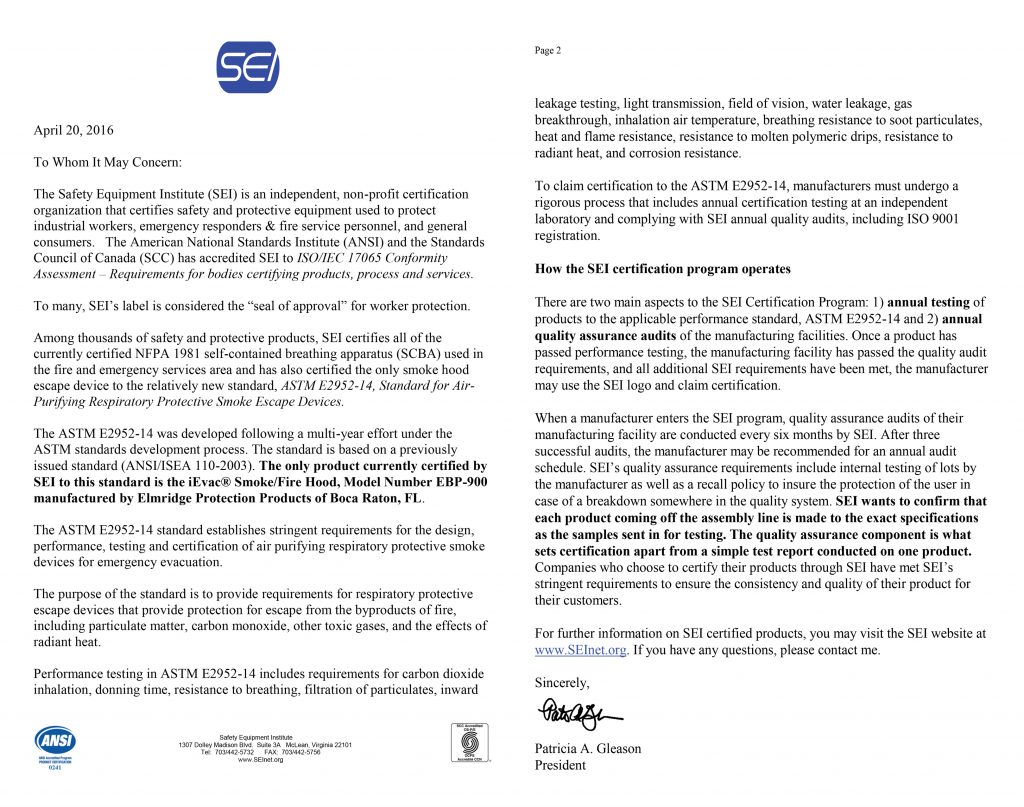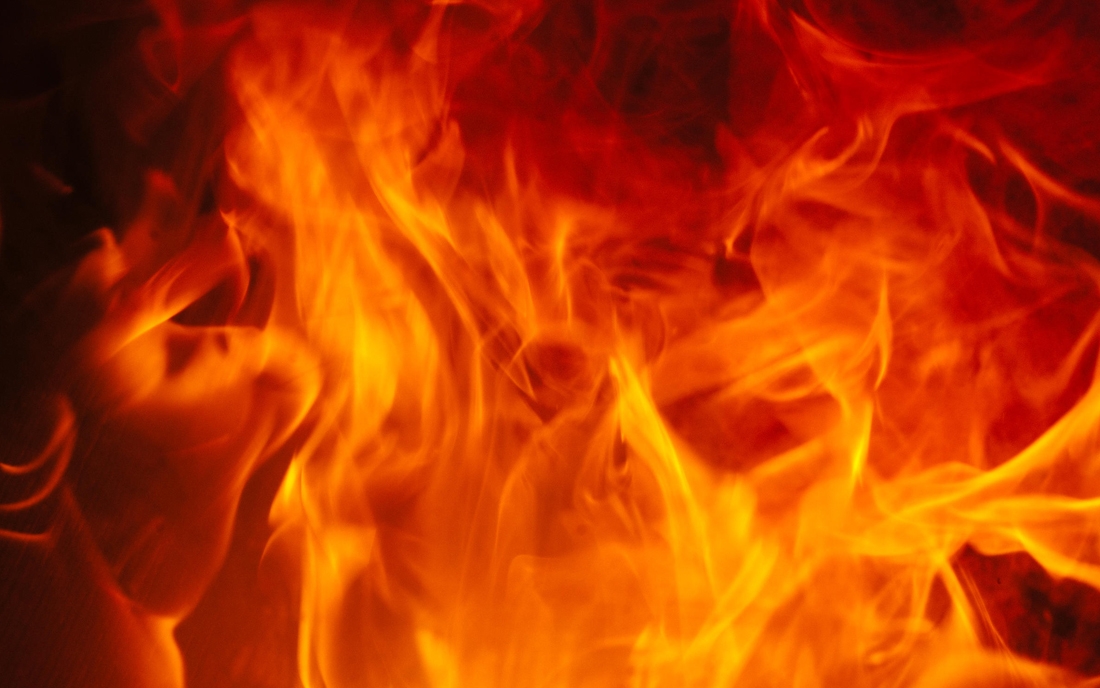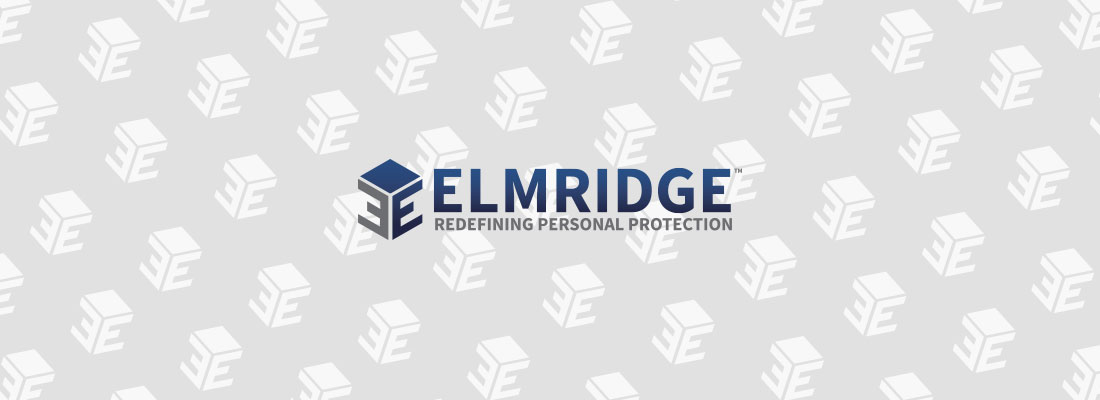Towering high-rise buildings that serve as hubs for various activities dominate the modern skyline. From bustling business operations to comfortable residentialliving, these architectural marvels have revolutionized urban landscapes.
They also come with unique challenges, particularly during critical situations like fires. Building safety in such environments requires meticulous evacuation plans and certified Smoke/Fire Hoods adhering to the American Society of Testing and Materials Standard Specification for Air-Purifying Respiratory Protective Smoke Escape Devices (RPED) (ASTM E2952). These elements play a pivotal role in safeguarding lives.
You can view the announcement here
https://online.fliphtml5.com/wlmso/vlmc/#p=41
Elmridge selected as the winner of the Escape Respirator Challenge by DHS
Ira Gurvitch, President of Elmridge is pleased to announce that the Department of Homeland Security has selected Elmridge as the winner of the Escape Respirator Challenge!
After fifteen months of research, development, prototyping and presentation, Elmridge was selected by the Department of Homeland Security as the winner of the Escape Respirator Challenge. This enables Elmridge to continue working closely with DHS in developing its’ next generation Escape Respirator, expected to be introduced to the market in 2021.
The Challenge was open to all manufacturers in the respiratory industry, bringing both large and small corporations to compete for the opportunity to work with DHS on the next generation escape respirator.
This is a major accomplishment for Elmridge and continues to strengthen our ongoing partnership with DHS.
You can view the announcement here
Holding Evacuation Smoke/Fire Hoods Up to the American Standard
By its very nature, an evacuation plan must be simple enough for everyone to understand and execute. At the same time, the plan’s effectiveness needs to be rigid enough to stand the test of a situation that’s full of variables, including: panic and mob mentality; unavailable exits; corrupted or shifting building infrastructure; and visibility and problems with the building’s air quality.
Even the best evacuation plan can and will have problems when faced with so many of these variables, depending on the length and severity of the condition. Monthly or quarterly fire drills can help, but in panic situations, it’s best that evacuees have the tools necessary to get out of a dangerous, life-threatening circumstance quickly and safely. Having American-certified fire escape hoods made available during an evacuation can help neutralize many of the variables found in an emergency situation, especially with air quality and visibility. However, many of the products in the market today are not certified to any standard. If an evacuation plan is tested for efficacy, how can an emergency manager make sure that an escape hood will be effective as well?
Glutted Marketplace
Confusion over escape hood options is very real. After 9/11, the marketplace was flooded with a number of different products that touted safety during an escape situation. In 2007, responding to a marketplace glut of questionable products, the Consumer Product Safety Commission tested a number of off-the-shelf escape products. Not one of these products passed the test.
So again, the question is how can a fire escape hood be integrated into an evacuation plan without questions being raised about its effectiveness? In light of the many sub-standard products on the market, an American ASTM (formerly American Society for Testing and Materials) Standard E2952 was established. This new ASTM standard defines both test criteria and approval methods. It contains general requirements for certification – independent process and quality control audits and follow-up inspection programs – and a comprehensive schedule of performance requirements and associated test methods.
Certified Solutions
To earn certification, the product must meet specified requirements for physical characteristics, including:
- Ease of donning, a full field of vision, exposure to vibration, puncture and tear, and extremes of pressure and temperature.
- Being tested with a series of chemical gases, including: carbon monoxide, hydrogen cyanide, sulfur dioxide, hydrogen chloride, acrolein and cyclohexane. These gases include those that are toxic byproducts of combustion and those that are effective indicators of performance against an entire class of gases.
- Escape hoods incorporated into an evacuation plan should be certified by the Safety Equipment Institute (SEI), which tests thousands of safety and protective products. SEI currently certifies all NFPA 1981 self-contained breathing apparatus (SCBA) used in the fire and emergency services.
Consider the Filter
Arguably, the most important part of the escape hood is its filtering system. Although it is possible to identify certain gases and particles as likely hazards in a fire escape situation, it is important to have a filtering system that is effective against both these specific hazards and also against others that might be encountered. The most effective escape hoods will need a combination filter to remove a wide range of particulates and gases.
- The best particulate filter is a high-efficiency particulate HEPA P100 filter. These will filter 99.97% or better of sub-micron particles out of the air.
- The best gas filter will contain a catalyst and impregnated activated charcoal. The catalyst is essential for turning toxic carbon monoxide, the number one cause of deaths during a fire, into non-toxic carbon dioxide. The impregnated activated charcoal works in tandem with the catalyst, removing toxic gases from the air and mitigating the effects of harmful gases generated by burning materials during a fire.
Incorporating American-certified escape hoods into an evacuation plan in an office or building can cut down on the number of fatalities and injuries experienced from smoke inhalation and visibility issues during an emergency situation. However, the product that is used needs to have proven efficacy before it can be added to any plan, meaning that only escape hoods certified by SEI to the ASTM E2952 standard should be considered. The fire escape hoods that have been certified to this American standard can be found on SEI’s Web site, www.seinet.com.
An emergency situation is neither the time nor the place to determine whether a product can live up to its claims.
iEvac® Smoke/Fire Hood ASTM E2952 Certification
The Safety Equipment Institute (SEI) is an independent, non-profit certification body that certifies safety and protective equipment used to protect industrial workers, emergency responders & fire service personnel, and general consumers. The American National Standards Institute (ANSI) has accredited SEI to ISO Guide 65, an internationally recognized standard used to accredit product certification bodies.
SEI’s label to many is considered the “seal of approval” for worker protection.
Among thousands of safety and protective products, SEI certifies all of the currently certified NFPA 1981 self-contained breathing apparatus (SCBA) used in the fire and emergency services area and has also certified the only smoke hood escape device to the relatively new standard, ANSI/ISEA 110-2003, American National Standard for AirPurifying Respiratory Protective Smoke Escape Devices.
Among thousands of safety and protective products, SEI certifies all of the
currently certified NFPA 1981 self-contained breathing apparatus (SCBA) used in the fire and emergency services area and has also certified the only smoke hood escape device to the relatively new standard, ASTM E2952-14, Standard for Air- Purifying Respiratory Protective Smoke Escape Devices.
The ASTM E2952-14 was developed following a multi-year effort under the
ASTM standards development process. The standard is based on a previously
issued standard (ANSI/ISEA 110-2003). The only product currently certified by
SEI to this standard is the iEvac® Smoke/Fire Hood, Model Number EBP-900
manufactured by Elmridge Protection Products of Boca Raton, FL.
The ASTM E2952-14 standard establishes stringent requirements for the design, performance, testing and certification of air purifying respiratory protective smoke devices for emergency evacuation.
The purpose of the standard is to provide requirements for respiratory protective escape devices that provide protection for escape from the byproducts of fire, including particulate matter, carbon monoxide, other to
Performance testing in ASTM E2952-14 includes requirements for carbon dioxide inhalation, donning time, resistance to breathing, filtration of particulates, inward leakage testing, light transmission, field of vision, water leakage, gas breakthrough, inhalation air temperature, breathing resistance to soot particulates, heat and flame resistance, resistance to molten polymeric drips, resistance to radiant heat, and corrosion resistance.
To claim certification to the ASTM E2952-14, manufacturers must undergo a rigorous process that includes annual certification testing at an independent laboratory and complying with SEI annual quality audits, including ISO 9001 registration.
How the SEI certification program operates
There are two main aspects to the SEI Certification Program: 1) annual testing of products to the applicable performance standard, ASTM E2952-14 and 2) annual quality assurance audits of the manufacturing facilities. Once a product has passed performance testing, the manufacturing facility has passed the quality audit requirements, and all additional SEI requirements have been met, the manufacturer may use the SEI logo and claim certification. When a manufacturer enters the SEI program, quality assurance audits of their manufacturing facility are conducted every six months by SEI. After three successful audits, the manufacturer may be recommended for an annual audit schedule. SEI’s quality assurance requirements include internal testing of lots by the manufacturer as well as a recall policy to insure the protection of the user in case of a breakdown somewhere in the quality system. SEI wants to confirm that each product coming off the assembly line is made to the exact specifications as the samples sent in for testing. The quality assurance component is what sets certification apart from a simple test report conducted on one product. Companies who choose to certify their products through SEI have met SEI’s stringent requirements to ensure the consistency and quality of their product for their customers.
For further information on SEI certified products, you may visit the SEI web site at www.SEInet.org.
Fire: The Overlooked Threat
People sometimes obsess over the potential threat posed by terrorist attacks that use things such as chemical weapons, electromagnetic pulses or dirty bombs. Yet they tend to discount the less exciting but very real threat posed by fire, even though fire kills thousands of people every year. The World Health Organization estimates that 195,000 people die each year from fire, while according to the Global Terrorism Database an average of 7,258 people die annually from terrorism, and that includes deaths in conflict zones such as Afghanistan and Iraq.
There are also instances in which fire is used as a weapon in a terrorist attack. U.S. Ambassador Christopher Stevens and embassy communications officer Sean Smith, the two diplomats killed in the attack on the U.S. office in Benghazi on Sept. 11, 2012, did not die from gunfire or even rocket-propelled grenade strikes but from smoke inhalation. This fact was not lost on the U.S. Department of State Accountability Review Board that investigated the Benghazi attack. In an interview published by Reuters on Feb. 24, former Ambassador Thomas Pickering, the head of the Accountability Review Board, said more attention should be paid to the threat fire poses to diplomatic posts.
Fire can be deadly and destructive. But whether a fire is intentionally set, as in the Benghazi example above, or is the result of an accident or negligence, there are some practical steps individuals can take to protect themselves.
Fire as a Weapon
The use of fire as a weapon, especially against diplomatic facilities, is not new. It was seen in the November 1979 sacking and burning of the U.S. Embassy in Islamabad, Pakistan, and in the April 1988 mob and arson attack against the U.S. Embassy annex in Tegucigalpa, Honduras. In February 2008, the
U.S. Embassy in Belgrade, Serbia, was heavily damaged when a mob lit its lobby on fire. More recently, on Sept. 14, 2012, three days after the Benghazi attack, millions of dollars’ worth of damage was done at the U.S. Embassy in Tunis, Tunisia, after a mob set outbuildings and vehicles ablaze. Fires set
by demonstrators also caused extensive damage to the adjacent American school.
Fire has been used to attack non-diplomatic facilities as well. During the November 2008 Mumbai attacks, the group of attackers holed up in the Taj Mahal Palace Hotel started fires in various parts of the hotel. Anarchists and radical environmental and animal rights activists have also conducted arson attacks against a variety of targets, including banks, department stores, the homes and vehicles of research scientists and even a ski resort.
Fire has also been a weapon frequently mentioned by al Qaeda in the Arabian Peninsula in its long-standing efforts to encourage Muslims living in the West to conduct simple attacks. In an interview featured in the first edition of Inspire magazine, al Qaeda in the Arabian Peninsula leader Nasir al-Wahayshi encouraged would-be jihadists to burn down forests and buildings as a way to strike terror into the hearts of their adversaries. This theme was expanded upon in Inspire magazine’s ninth edition, which actually contained a photo tutorial on how to construct timed incendiary devices as well as a fatwa noting that it was religiously permissible to light forest fires as an act of war. It is suspected that Palestinian groups have also been responsible for a number of fires in Israel and the West Bank.
But fire is not a weapon to be used against only buildings and forests — it can also be used to attack transportation targets. In March 2008, a Uighur separatist attempted to light a fire in the restroom of a China Southern Airlines flight from Urumqi to Beijing using two soft drink cans filled with gasoline that she had smuggled onto the flight. Fire is extremely dangerous aboard aircraft because of the oxygen-rich environment, the sensitive nature of avionic controls, the presence of thousands of gallons of jet fuel and the toxic smoke that results from burning plastics and other materials that make up a plane. Examples of deadly fires aboard aircraft include the September 1998 incident involving Swissair Flight 111, in which all 229 people aboard were killed after the crew was overcome by smoke, and the May 1996 ValuJet crash in the Florida Everglades. In a case similar to the one at hand, a June 1983 fire that started in the restroom of Air Canada Flight 797 resulted in the deaths of 23 of the 46 passengers on board. Autopsies showed that most of them died as a result of smoke inhalation.
Trains have also been targeted for arson. In August 2006, an attack against two German trains failed when the timed incendiary devices placed onboard failed to ignite. A February 2007 attack against a train in India proved far more deadly. Two timed incendiary devices placed aboard the Samjhauta Express killed 68 people and injured another 50. Two additional unignited devices were later found in other cars aboard the train. Had they functioned properly, the death toll would have been much higher.
Incendiary devices are not only quite deadly if properly employed, they also have an advantage over explosive devices in that they can be constructed from readily available materials such as gasoline and kerosene. Even the aluminum powder and iron oxide required to manufacture a more advanced incendiary compound such as thermite can be easily obtained or even produced at home.
Another consideration is that quite often other forms of attacks, such as those using explosive devices, rocket-propelled grenades or even tracer ammunition, can spark fires. Many of the victims of the July 7, 2005, London subway bombings were affected not by the bombs’ blast effect but by the smoke from the resultant fires.
Precautions
In addition to the threat of fire as a weapon or resulting from another form of attack, many deadly fires result each year from accidents or negligence. Such fires are deadly enough in the United States and Europe, where there are strict fire codes, but their impact is often magnified in less-developed countries, where fire codes are nonexistent or poorly enforced. For example, while sprinkler systems are mandatory for hotels in the United States, in many parts of the world they are not required.
When I was working on protective details overseas, I learned that it is not uncommon to find items stored in emergency stairwells, leaving them obstructed or sometimes impassable. It is also not unusual to find fire doors that have been chained shut due to the criminal threat.
One thing that can be done to mitigate the threat from fire is to check emergency exits to ensure that they are passable. This applies not only to hotels but also to apartment and even office buildings. In the August 2011 Casino Royale attack in Monterrey, Mexico, the attackers ordered the occupants out of the building before dousing it with gasoline and lighting it on fire, but 52 people died in the incident because they were trapped inside a building by a fire exit that had been chained and locked shut.
While we recommend that travelers staying at hotels overseas should attempt to stay above the second floor for security reasons, we also recommend that they not stay above the sixth floor so that they will be within range of most fire department rescue ladders. We also recommend checking that functional and tested fire extinguishers and fire hoses are present.
In fires, smoke inhalation is a huge problem. According to studies, it is the primary cause of fire deaths and accounts for some 50-80 percent of all deaths from indoor fires. While this is somewhat obvious in confined spaces such as an aircraft fuselage or a subway tunnel, it also applies to buildings. Even buildings that are constructed of concrete or cinderblock and would therefore seem to be resistant to the effects of fire can serve to confine smoke to deadly levels. The U.S. office in Benghazi is a very good recent example. Video of the building after the attack showed that the fire had not badly damaged the building’s structure itself; what killed Stevens and Smith was the smoke.
As Stratfor has noted for many years now, smoke hoods are a very important piece of safety equipment and should be part of everyone’s personal safety plan. Smoke hoods can be carried in a purse or briefcase and can provide the wearer with 15-30 minutes of safe air to breathe. This period of time can make a world of difference to a person caught in a burning building, subway tunnel or aircraft and attempting to escape to fresh air.
Due to past fire incidents on aircraft, the Federal Aviation Administration mandates that airlines furnish a smoke hood for each crew member on commercial flights. They do not provide smoke hoods for each passenger, although high-end executive aircraft normally do. Commercial passengers who would like access to a smoke hood in the case of a fire need to carry their own. Another useful tool in such situations is a small, high-intensity flashlight that can help you find your way through the smoke or dark once you have donned your smoke hood.
Fire is a potentially deadly weapon, one that should not be forgotten, but steps can be taken to mitigate the danger it poses.
Article Author

Scott Stewart
Scott Stewart supervises Stratfor’s analysis of terrorism and security issues. Before joining Stratfor, he was a special agent with the U.S. State Department for 10 years and was involved in hundreds of terrorism investigations.
Fire: The Overlooked Threat is republished with permission of Stratfor.
FIRE SAFETY INNOVATOR CALLS OUT COMPETITORS
iEvac Manufacturer Challenges Other Products on the Market to Submit For Stringent Testing and Accreditation
NEW YORK – November 9, 2009 – Elmridge Protection Products, manufacturers of the iEvac – the only U.S. certified, life-saving air-purifying escape hood that provides the protection and time needed to escape from harmful fire-related gases, particles and physical hazards, announced today that it is calling upon other Respiratory Protective Escape Devices (RPEDs) manufacturers to meet the current American National Standard, in order to ensure the consumer market has safe choices in fire protection.
“There are a number of products on the market making wildly inaccurate claims about their ability to provide breathable, filtered air to a person evacuating a fire. Continuing to make these assertions without submitting their products for testing under the new American Standard is, quite frankly, irresponsible.”
-Ira Gurvitch, President Elmridge Protection Products
The iEvac is currently the only product on the market that meets and exceeds the American National Standard ANSI/ISEA 110, which tests RPEDs on their ability to both withstand the environment produced by a fire, as well as protect the wearer against toxic gases, harmful particulates and life-threatening physical hazards.
“There are a number of products on the market making wildly inaccurate claims about their ability to provide breathable, filtered air to a person evacuating a fire. Continuing to make these assertions without submitting their products for testing under the new American Standard is, quite frankly, irresponsible,” said Ira Gurvitch, president of Elmridge Protection Products. “Home, business and building owners need to feel the products they are trusting with their safety in a fire will work as promised. An emergency situation is not the time to find out that a product doesn’t deliver. This new standard ensures the products brought into an evacuation plan will be the products that bring evacuees out safely.”
As the only product that can claim American certification, the iEvac has been tested by Intertek, Assay Technology and the U.S. Army Research, Development and Engineering Command, Edgewood Chemical Biological Center, manufactured in an ISO 9001 facility and certified by Safety Equipment Institute (SEI). Qualified by the U.S. Department of Homeland Security, Office of the Safety Act, as an anti-terrorism technology, iEvacs have been purchased by the military; international, federal, state and local agencies; law enforcement; major corporations, high-rise building management, consumers and multi-dwelling building owners. About iEvac The iEvac is the only U.S. certified, life-saving air-purifying escape hood that provides the protection and time needed to escape from harmful fire-related gases, particles and physical hazards. The first fire hood to extend professional protection to the consumer markets, the iEvac offers a lifeline to residents and tenants of multi-dwelling units and office buildings, concerned with safely navigating an escape route. It enables people to avoid the inhalation of smoke and dangerous gases like carbon monoxide – the number one killer of people in fires. The iEvac, along with a number of other life-safety solutions, are produced by Elmridge Protection Products. Please visit http://www.elmridgeprotection.com for more information.








